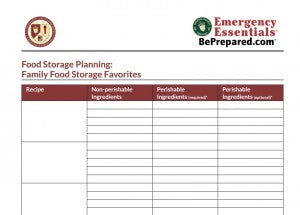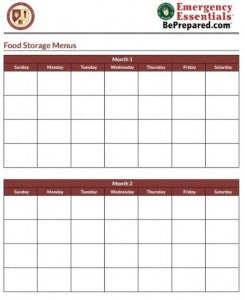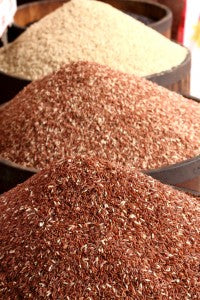
When an emergency strikes, you’re often left to your own skills and preparation to provide for you and your family. Food is one of the major necessities of life that you want to have on hand when an emergency hits, whether a natural disaster, an economic crisis, or health issues. If you haven’t thought to prepare before a disaster yet, now is the time to start because once it strikes, the time to prepare is over.
As you work to build your food storage supply, consider these 12 Dos and Don’ts of Food Storage:
1. DO carefully plan your food storage supply. Keep a record of what you and your family like to eat and then build those items into your food storage supply. Budget carefully and buy food items when they’re on sale. It’s a good idea to build a short-term supply quickly, but one of the perks of building a long-term supply is that you can build over time, giving yourself time to plan and wait for all the good deals.
2. DO build a menu. Building a two-week, one-month, or even three-month food storage supply can be pretty simple and stress free. To decide how much food you need, build a menu and then multiply it.
For example, if you want to build a food supply to last your family for 3 months, then you'll need 12 weeks of food. Build a menu for one week, two weeks, or even a month.


Once you build your menu, build a list of the food you need, and then multiply it. For example, multiply a one-week menu by 12 (weeks), a two-week menu by six, or a one-month menu by three. Pretty easy, no?
3. DO store basic ingredients first. Adding staple ingredients into your supply will help provide you with the necessary ingredients that help create a variety of homemade meals. Add food staples such as wheat, flour, grains/legumes, rice, cornmeal, oatmeal, honey, sugar, powdered milk, dried whole eggs, baking powder, salt, spices, pasta, etc.

The old saying goes, “You can’t live by bread alone,” but according to Peggy Layton, author of
Emergency Food Storage & Survival Handbook, “you
can live on bread
and soup.” In her book, Peggy describes the endless combinations and variations you can make with bread and soup…which would not only be delicious but would also help you survive in an emergency.
Another food item that can help you survive is storing the basic ingredients for bread. With these staples, you can bake quick breads (banana bread, zucchini bread, lemon poppy seed bread), yeast breads (white or wheat, bread sticks, and scones), dessert breads (cake, pie crusts, and cookies), and breakfast breads (pancakes, waffles, muffins, cornbread).
[ii]
Match those breads with variations of hearty
soups and stews using different soup mixes and an addition of your favorite
vegetables and
meat, for endless possibilities.
4. DO eat what you store and store what you eat. Make sure you only buy food to store that your family will actually eat. If they won’t eat
lentils before an emergency, they won’t be happy about eating them
during one, either. So get food that your family likes to eat on a regular basis…and then eat it.
Rotating through your food storage will help your family get used to it and will minimize losing nutrition and flavor (which can happen when you wait too long for an emergency before you break it open). If you rotate through your food storage, then you’ll always have the freshest foods available to you.
As you use your food, keep a food inventory list handy and mark the items off of the list as you use them so you know what you need to replace.
Learn more with our Insight Articles, “
Eat What You Store” and “
Rotating Your Food Storage”
5. DO store food based on special needs for family members. Make sure that you have a variety of food stored to satisfy each member of your family and that’s appropriate for all ages. Include baby foods and consider any food allergies family members may have when planning what to store.
6. DO store your food storage in a cool (70° or lower), dry, and dark place—like a basement. There are four factors that contribute to how long your food storage items will last: light, temperature, moisture, and oxygen. The less interaction your food has with these four factors, the longer it will last.
Learn more about proper storage conditions with our Insight Article, “
Shelf Life”
7. DON’T let yourself get overwhelmed. Often when building a food storage supply, the task can seem daunting from a distance. All you have to do, though, is start small.
Begin adding items to your emergency supply to help your family survive for three days, then a week, then a month, and so on. You can also include food storage items into your weekly grocery shopping. By doing this, you’ll gradually build your supply (which is easier on your pocketbook) and before you know it you’ll have enough to help you survive for your chosen amount of time.
8. DON’T think you have too little space to store food. Whether you live in a 3-story home or the tiniest apartment in the world, you can Replace a place for your food storage. It may not meet the ideal storage conditions, but it’s better than no storage at all! Check out some of these tips for where you can store your food if you’re tight on space:
- Under the bed (you can even hide your storage with a dust ruffle)
- Use them to create bookcases/shelving to hold more cans by laying a wooden board across four cans (two on each end) and stacking more cans and boards until your shelf is the size you’d like.
- Build your own food storage shelf that slides into the wasted space between your refrigerator and wall.
- Use larger bins, such as SuperPails, as end tables or coffee tables. Simply disguise it as furniture by covering them with tablecloths.
- Stack them behind your couch where there is wasted space between the couch and wall.
- Fill the dead space in your coat closet. Typically there is quite a bit of vertical space underneath your coats in the closet. It’s a great, accessible place to store your food.
9. DON’T store your food near chemicals or cleaning products. You don’t want to risk contaminating your food storage supply if any dangerous products were to leak—especially if you don’t Replace the contamination until you need your food in an emergency.
10. DON’T use non-food-grade plastic containers to store food. If you plan to dehydrate, can, or store your own food, make sure to keep it in a non-toxic, food-grade container such as glass, ceramic, or stainless steel. Non-food-grade plastic containers are not good for long-term storage as they can leach chemicals into your food. Keep your food in double-enameled, stainless steel cans (or
metallized bags) with an
oxygen absorber to help them last longer. You can also store large quantities of food in
Superpails lined with metallized bags, which use food-grade plastic, making them safe for long-term storage.
11. DON’T wait until an emergency to learn to cook with freeze-dried and dehydrated foods. Although cooking with food storage ingredients isn’t difficult, it is a little different than cooking with fresh ingredients. As you rotate through your food storage, try out different [recipes] that can help you make home-cooked meals so delicious that your family would never guess they’re from food storage.
Check out some of our favorites:
12.
DON’T forget to store food for your pets. If you are a pet owner, make sure you include enough pet food for them to be able to survive during an emergency, too.
Make all the prepping and planning involved in building your supply, just a little easier by using our
pre-made worksheets, menu calendars, and inventory sheets to help you stay organized.
For more tips, check out some of our Insight Articles:
--Kim
Sources:
/media/wysiwyg/PDF/Prep-School-Food-Storage-101.pdf
/insight/13483/5-tips-for-building-your-food-storage/
http://www.slcohealth.org/programs/foodprotection/factSheetsBrochures/foodStorageDoDont.html
http://survivallife.com/2012/11/29/13-dos-and-donts-of-food-storage/
https://shine.yahoo.com/green/10-dos-and-donts-for-a-greener-pantry-2474410.html
[i] Food Storage For the Health of It by Azrcka Bedgood
[ii] Emergency Food Storage & Survival Handbook by Peggy Layton. Pg. 59-64; 75-77; 88;





20 comments
beprepared
John,
Thanks for your comment! I think root cellars are coming back. I take care of our Pinterest page as well and I’ve noticed a lot of pins about root cellars. Do you know, what are the benefits of storing food in a root cellar besides it doubling as a storm shelter? I know that light and temperature would be covered pretty well, right?
Angela
John McDonald
Remember where our grand, and great grand parents used to store canned foods, in a root cellar, which also can double as a storm shelter and hiding spot if the entrance is disguised. Good advise throughout the bog and comments, KEEP IT UP!
beprepared
NamVet67-69,
Thanks for that suggestion! Have you personally done this to protect your food storage? How did you come up with this idea?
Angela
NamVet67-69
You could store cans and other things inside a 55 gal. drum that has a removable lid which can be sealed. The drums should keep everything safe in a flood.
Visalia Cowgirl
Under your home in a cool space that stays an even temp is good, in big plastic containers.
beprepared
Jerry,
Thanks for your question. Unfortunately, we do not currently sell 32 gal. food grade trash can liners. I’d suggest looking online for them (I did a google shopping search that brought up a lot of results). Also, you can purchase them at Costco. I’m sorry we don’t sell them here, but I hope this helps.
Angela
beprepared
Kenneth,
That’s true—basements do run a greater risk for flooding. Where would you suggest storing food instead? Or do you think there’s a way that people could store food in the basement so that it doesn’t get damaged by flooding? What are your thoughts?
Angela
beprepared
Harry and Don,
We’ve gotten several comments about this concern. And yes, it is a truly valid concern—what do you do if your fridge heats up? We found this tutorial at the website classyclutter.net and they’ve been asked this question several times as well. Here’s what they had to say: The people at Classyclutter.net (where we found the tutorial) were asked this question as well. The woman who created the post on classyclutter.net said this “My refrigerator does not heat up on the sides and over the past year, I have had absolutely no issues with food spoiling from any heat. The fridge is completely cool to the touch.”
However, this doesn’t really help someone whose fridge heats up. This is where judgement comes into play—if your fridge heats up, it might not be the best idea to make this particular food storage shelf. But if it doesn’t heat up, this could be a good option. There are other tutorials for food storage shelves to check out and to use to store your food. We provide a link to more tutorials to check out as alternatives to this one. Check out this website for more shelf ideas: diyncrafts.com
Angela
beprepared
Kari,
Glad we could be of help to you. I think it’s excellent that you are rotating your stored foods into your regular menus. What types of foods do you dehydrate?
Angela
beprepared
Edith,
Thanks for your comment. That is a great tip. Sprouting is a great way to get the nutrients you need, even if you can’t grow a garden.
Angela
beprepared
JD,
That is a great way to use the space you have to store your supplies. Sometimes people find it hard to find places to store things, but you have to get creative, you know? Do you store your supplies in any other ways to save space/use the un-used spaces you have?
Angela
don
Don’t do this, it will cook your supplies, too hot of a place to store food "Build your own food storage shelf that slides into the wasted space between your refrigerator and wall".
JD
We used food storage to make the foundation for the bed
in our guest room. It takes a minimum of 18 cases that hold 6, #10 cans to make a foundation for a queen size mattress. 36 cases would make it a more standard height to cover with a dust ruffle!
Edith
I didn’t see the admonition to store seeds for sprouting—only way to guarantee a supply of fresh vegetables, and with more nutrition than any other source.
Kari Geiger
This is some of the best advice I have ever seen on why you should store food. But the time has come where you MUST store food. The economic climate in the world is such that a healthy "store" in your home is better than gold. You can’t eat gold!!! I am a survivor of the Y2K scare that taught me a great deal. There was a lesson to be learned from that. Result, I spent the past year dehydrating food on my own and heat sealing bags full of good food. We now rotate that through our regular monthly menu cycle. I found Emergency Essentials just recently and am spending this 4th of July holiday planning to incorporate the items I can’t treat for storage on my own.
Thank you so much for being out there to help all of us.
Harry Hingst
Between the refrigerator and the wall is NOT a good space for food storage. This area receives all of the heat generated by the refrigerator condenser coil that is either beneath the refrigerator, on the back of some refrigerators (older units) or in the outer walls on some smaller refrigerators (primarily like a dorm size unit.)
thomas
good ideas, but there are 13 weeks in a 3 month period so add in one extra week woth of food
Jerry
ware can I find 32 gal. food grade trash can liners?
Kenneth H. Conner
Storing food in a basement could be a bad idea. In case of power failure the food could end up under water as the sump pump goes out.
LJ
Like everything except using the space between a wall and the side of the refrigerator. I have seen this before and never understood why we constantly told to keep items below 70 degrees, yet this tells you to place items near a major producer of heat from the refrigeration process. Also, next to the bathroom, your kitchen is usually the second most humid spot in your house from cooking. I would say use this space to put your week to week foodstuffs to free up space in other areas you would normally store them for you long term foodstuffs.